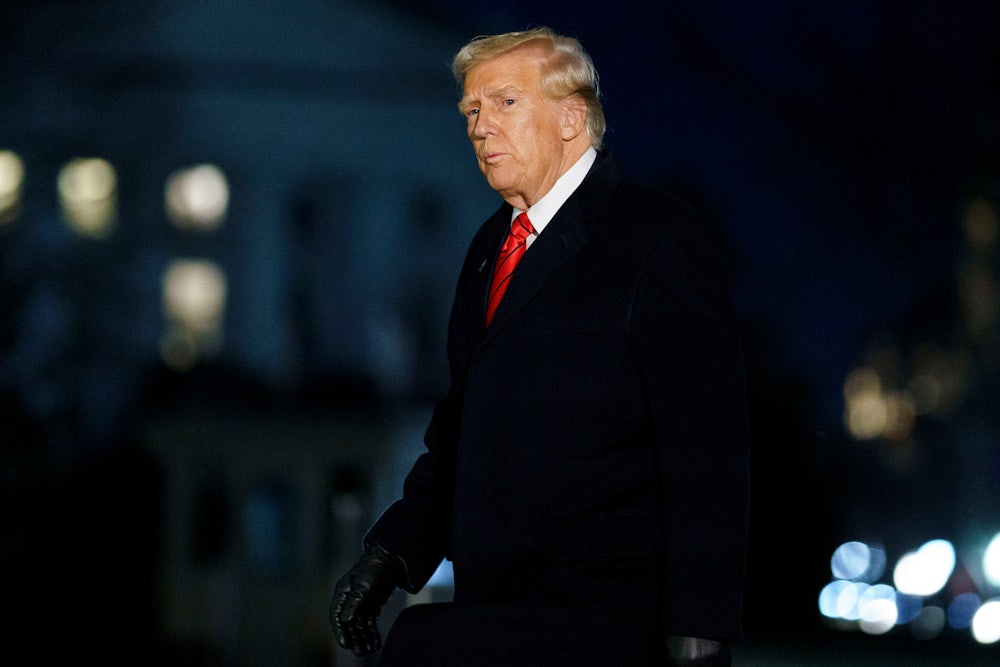President Donald Trump’s second term began with a war on the separation of powers. His administration has already sought to dismantle the nonpartisan civil service despite statutory protections, fire lawfully protected agency commissioners and employees, and usurp Congress’s power of the purse by freezing trillions of dollars in appropriated funds. Now his quest for executive autocracy is taking aim at the federal nature of American governance.
In a series of executive orders since taking office, Trump has sought to pressure, command, and even intimidate state and local officials across the country into carrying out his whims. Tensions between state and federal power are hardly new to American history. But the president’s eagerness to bulldoze state and local power is a disturbing escalation of his autocratic approach to government.
Education, for example, is a policy area that is typically guided by state and local governments. The federal Department of Education exercises some influence through its funding programs; Trump and other conservatives have long sought to abolish it and claimed they wanted greater local control over what students learn. That goal appears to be on hiatus for now: Trump issued an executive order last week titled “Ending Racial Indoctrination in K-12 Schooling” that hopes to use the department as an ideological cudgel.
The order aims to eliminate what it describes as “discriminatory equity ideology,” a term that apparently refers to critical race theory and similar concepts, as well as “gender ideology,” which it describes as efforts to “socially transition” children into changing their gender. “Demanding acquiescence to ‘white privilege’ or ‘unconscious bias’ actually promotes racial discrimination and undermines national unity,” the order claimed.
In its place, the president hopes to enshrine what he describes as “patriotic education” in American schools. How will he accomplish this goal? The order directed the secretary of education and other Cabinet officials to develop an “Ending Indoctrination Strategy” for “eliminating federal funding or support for illegal and discriminatory treatment and indoctrination in K-12 schools, including based on gender ideology and discriminatory equity ideology.”
Cutting off federal education funds based on a vague executive order would all but invite a host of legal challenges. Some of these would mirror other brewing court clashes over the White House’s efforts to withhold federal funds. But the Trump administration could face even greater hurdles here than in other policy areas: Chalkbeat, an education-focused news outlet, noted last week that federal law actively prohibits federal officials from imposing specific curricula on schools or requiring them to adopt specific teaching materials.
Trump’s most aggressive efforts to alter the state-federal relationship can be seen in immigration policy. Where education is traditionally a state responsibility, immigration exclusively falls within federal jurisdiction. To that end, the White House is targeting “sanctuary” cities and states that refuse to cooperate with federal immigration enforcement. One of his initial executive orders directed the federal government to “evaluate and undertake any lawful actions to ensure that so-called ‘sanctuary’ jurisdictions … do not receive access to federal funds.”
The president has long railed against sanctuary jurisdictions for refusing to cooperate with his deportation plans. On the campaign trail, he often threatened to focus most of his deportation efforts in those communities and suggested that he would use the military to supplement existing federal agents. Indeed, cutting off federal funds from these jurisdictions is not a new strategy: The Trump Justice Department attempted to cut off certain law enforcement grants early in Trump’s first term, only for a federal judge to issue an injunction after concluding it was likely illegal. The administration may be hoping that the Supreme Court will be more favorable this time around.
But there are signs of escalation on that front, especially compared to how Trump carried out immigration policy during his first term. The president’s first-wave order also directed the attorney general and secretary of homeland security to “evaluate and undertake any other lawful actions, criminal or civil, that they deem warranted based on any such jurisdiction’s practices that interfere with the enforcement of federal law.” That language raises the possibility that federal prosecutors will try to bring criminal charges against state and local officials who decline to help with immigration enforcement.
Trump and his allies have floated this option from time to time in recent years. America First Legal Foundation, a conservative legal group founded by top Trump ally Stephen Miller, sent letters to California counties that warned they could face criminal prosecutions for their sanctuary policies. It named nearly 250 state and local officials in California alone who could face unspecified charges or civil lawsuits for racketeering charges.
One early glimpse into that strategy came last week when the Justice Department announced it would open an investigation into Derek Osborne, the sheriff of Tompkins County, New York. Emil Bove, the acting deputy attorney general, claimed that Osborne had released an undocumented immigrant who had served an assault sentence from the local jail before federal agents could arrive to take him into custody.
It is generally unconstitutional for state and local officials to actively obstruct federal officials from carrying out their lawful duties. Whether state and local officials are required to cooperate with their federal counterparts is a different story. The Supreme Court, for example, has occasionally invoked what is known as the anti-commandeering doctrine to overturn federal laws that compel states to undertake specific policies, like requiring local officials to perform background checks on gun purchases or barring state legislatures from legalizing sports betting. Prosecuting mayors, sheriffs, and county commissioners for not enforcing or helping to enforce federal laws would amount to a major constitutional breach.
Naturally, some Republican-led states have leapt at the opportunity to assist the Trump administration. In Tennessee, lawmakers passed a bill that would create a state agency to specifically assist with deportations. Tennessee is not a sanctuary state and has laws prohibiting its cities and counties from becoming them. But the bill goes even further by also making it a criminal offense for state and local officials to vote to adopt sanctuary-like policies. Criminalizing specific votes on legislation is perhaps unprecedented in American legal history. The law would likely face serious First Amendment challenges if it were enforced.
Trump’s hostility toward federalism goes beyond specific executive orders and policy disputes. He appears unwilling to treat Democratic-led states as legitimate constitutional actors. Last week, for example, the president announced that he had launched a military invasion of California over its water-use policies and the deadly wildfires around Los Angeles. “The United States Military just entered the Great State of California and, under Emergency Powers, TURNED ON THE WATER flowing abundantly from the Pacific Northwest, and beyond,” he wrote on Truth Social, his private social media website.
Trump and other conservative leaders have responded to the tragic wildfires by condemning California’s liberal approach to governance and making unprecedented demands for change before the state receives any potential federal disaster relief. This is unsurprising in one sense, given that Republican politicians and right-wing media outlets have spent decades denigrating the Golden State to discredit progressive policies among their supporters.
But Trump’s false assertion that he used military force to bring California to heel goes beyond the usual blue-bashing. (In reality, federal officials merely reactivated reservoir pumps that had been offline for maintenance; Southern California’s water supplies were never actually in doubt.) For the president to lie about sending in military forces to a state—not to enforce federal court orders, or protect civil rights, or suppress a genuine rebellion—is a disturbing sign for how things could escalate over the next four years.
Every American schoolchild learns—well, at least for now—that the Constitution’s Framers divided power among different branches and levels of government. They did not do it for fun; they embraced federalism and the separation of powers because they hoped it would best prevent corruption and dictatorship. It would be easy to dismiss these actions as another chapter in the 250-year history of state-federal tensions. But that would be a mistake. Trump is not interested in rewriting the balance of power between Washington, D.C., and the states. He is simply steamrolling anything that stands in his way.










